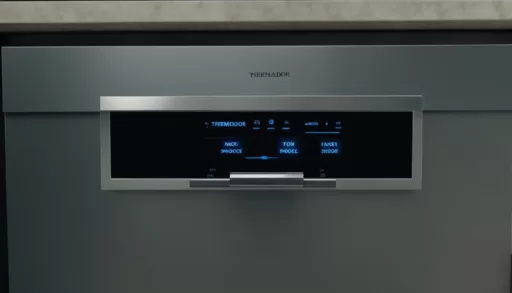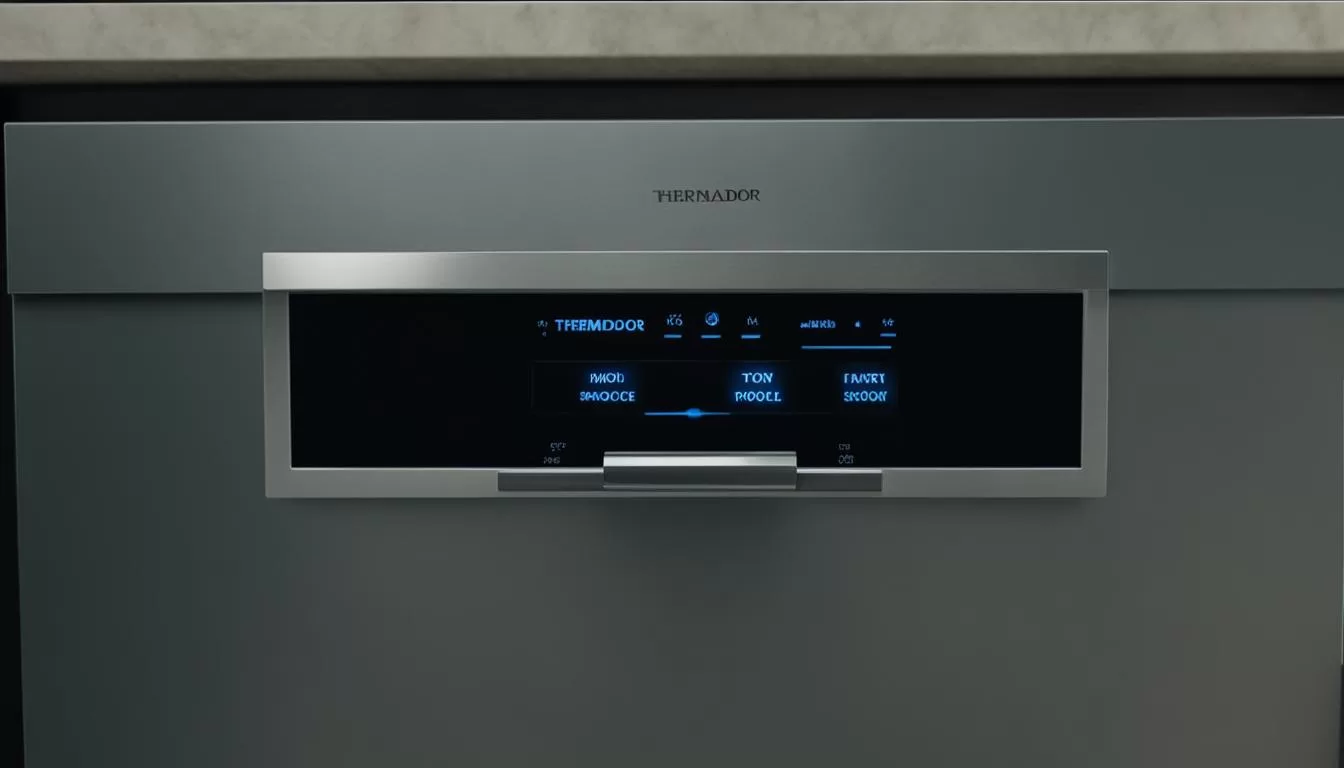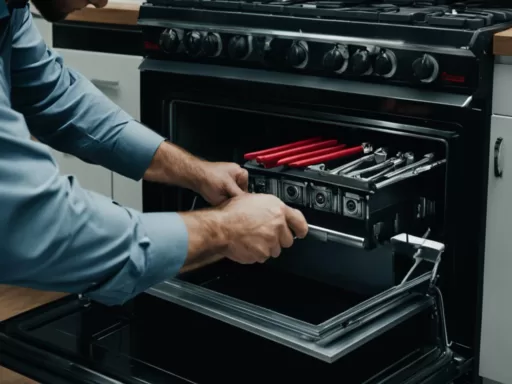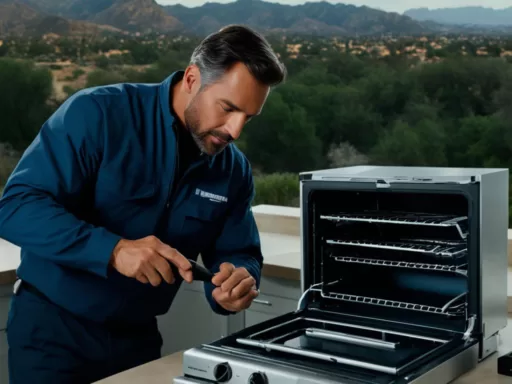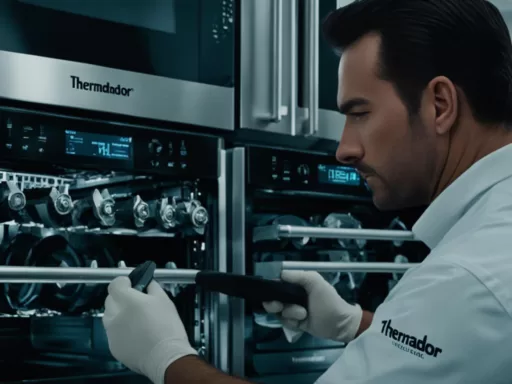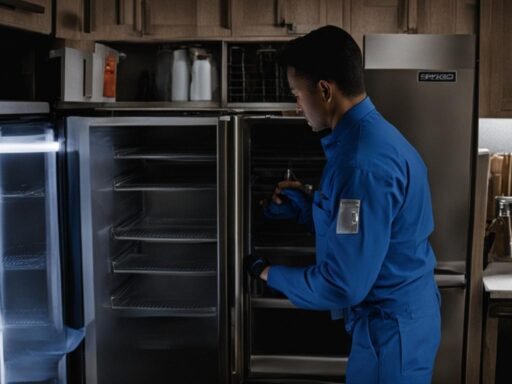When it comes to Thermador dishwasher repair, it’s important to have the right knowledge and troubleshooting tips to keep your appliance running smoothly. Whether you’re dealing with issues related to cleaning performance, drainage, or maintenance, understanding the necessary steps can save you time and money.
In this comprehensive DIY guide, we’ll explore some essential tips and techniques for Thermador dishwasher repair. From troubleshooting common problems to maintaining key components, you’ll learn how to address issues effectively and keep your dishwasher in optimal condition.
Key Takeaways:
- Regularly inspect and clean the spray arms to ensure proper dishwashing performance.
- Use the correct dishwasher detergent and the recommended amount for each load.
- Check for white spots on clean dishes, which may indicate hard water or etching issues.
- Troubleshoot drainage problems by clearing blockages in the drain lines and cleaning the filter.
- If unable to resolve an issue, consider contacting professional Thermador dishwasher repair services.
Troubleshooting Tips for Thermador Dishwasher Not Cleaning Well
If you’re experiencing issues with your Thermador dishwasher not cleaning dishes effectively, there are several troubleshooting steps you can take to identify and resolve the problem. Commonly, this problem can be caused by a variety of factors, including water supply issues, incorrect dishwasher usage, or malfunctioning parts. By following these troubleshooting tips, you can improve the cleaning performance of your Thermador dishwasher.
-
Check the water temperature: Ensure that the water entering your dishwasher is hot enough to effectively clean the dishes. The recommended water temperature for most dishwashers is 120°F (49°C) to 150°F (66°C).
-
Assess for hard water: Hard water can leave mineral deposits on dishes, affecting the cleaning performance. If you suspect hard water, consider using a water softener or adding a dishwasher cleaner specifically designed for hard water.
-
Inspect the water inlet valve: The water inlet valve controls the flow of water into the dishwasher. If it is faulty or clogged, it can affect the cleaning performance. Ensure that the water inlet valve is clean and functioning properly.
-
Ensure proper usage of detergent: Using insufficient or improper detergent can lead to poor cleaning results. Make sure you are using a dishwasher detergent specifically recommended for your Thermador dishwasher and follow the manufacturer’s instructions for the correct amount to use.
-
Check for clogged spray arms: Clogged spray arms can obstruct the distribution of water and detergent in the dishwasher. Remove the spray arms and clean any debris or blockages that may be present. This will help ensure a proper spray and thorough cleaning.
By following these troubleshooting tips, you can improve the cleaning performance of your Thermador dishwasher and enjoy sparkling clean dishes with every cycle.
Customer Review:
“I was frustrated with my Thermador dishwasher not cleaning well, but after following the troubleshooting tips mentioned above, my dishes are now spotless. Checking the water temperature and cleaning the spray arms made a significant difference. Highly recommend trying these solutions!”
| Issue | Troubleshooting Step |
|---|---|
| Water Temperature | Check that the water temperature entering the dishwasher is between 120°F (49°C) and 150°F (66°C). |
| Hard Water | Use a water softener or dishwasher cleaner designed for hard water to resolve mineral deposit issues. |
| Water Inlet Valve | Inspect and clean the water inlet valve to ensure proper water flow. |
| Detergent Usage | Use the correct amount of dishwasher detergent recommended for your Thermador dishwasher. |
| Clogged Spray Arms | Remove and clean the spray arms to eliminate any blockages hindering proper water distribution. |
Tips for Dealing with White Spots on Clean Dishes in Thermador Dishwasher
If you’ve noticed white spots on your clean dishes after a cycle in your Thermador dishwasher, it’s important to address this issue to ensure sparkling, spotless results. The presence of white spots can be attributed to two main factors: hard water and etching. Let’s explore some tips to tackle this problem and maintain the optimal performance of your Thermador dishwasher.
1. Increase the Use of Rinse Aid
Incorporating more rinse aid into your dishwasher routine can help eliminate white spots on your dishes. Rinse aid helps to prevent minerals from depositing on the surfaces of your dishes, ensuring a pristine and shiny finish. By using the appropriate amount of rinse aid recommended for your Thermador dishwasher, you can minimize the effects of hard water and reduce white spots.
2. Add Extra Salt for Built-in Water Softening Systems
If your Thermador dishwasher is equipped with a built-in water softening system, adding additional salt can significantly improve its performance. The salt helps to offset the effects of hard water, reducing the formation of mineral deposits and white spots on your dishes. Refer to your appliance manual for specific instructions on adding salt to your Thermador dishwasher.
3. Adjust the Wash Settings
Adjusting the wash settings on your Thermador dishwasher can also make a difference in preventing white spots on your dishes. Ensure that the water temperature is set at the recommended level to optimize detergent dissolving and cleaning performance. Additionally, selecting the appropriate wash cycle for your load can help remove residues effectively, preventing the occurrence of white spots.
By implementing these tips, you can address the issue of white spots on your clean dishes and maintain the excellent cleaning performance of your Thermador dishwasher.

| Common Causes of White Spots on Dishes | Solutions |
|---|---|
| Hard water mineral deposits | Increase the use of rinse aid Add extra salt for built-in water softening systems Adjust the wash settings |
| Etching caused by corrosive dishwasher detergents | Switch to a milder detergent Use a smaller amount of detergent |
Maintaining the Spray Arms in Your Thermador Dishwasher
Regular maintenance of the spray arms in your Thermador dishwasher is crucial for ensuring optimal performance and clean dishes. Over time, debris and mineral deposits can accumulate in the small holes of the spray arms, obstructing water flow and compromising the effectiveness of the washing and rinsing cycles.
To maintain the spray arms and prevent blockages, follow these simple steps:
- Before proceeding with any maintenance tasks, ensure that the dishwasher is powered off and disconnected from the power source for safety reasons.
- Locate the spray arms inside the dishwasher. They are typically located on the bottom and top racks and can be easily identified as rotating arms with small holes.
- Gently remove the spray arms by unscrewing or unlatching them, depending on the model of your Thermador dishwasher.
- Rinse the spray arms under running water to remove any visible debris or food particles. Use a toothpick or a thin wire to dislodge any stubborn blockages from the holes.
- Inspect the spray arms for any signs of damage or wear. If you notice any cracks or significant wear, it’s advisable to replace the spray arms with genuine Thermador dishwasher parts to ensure optimal performance.
- Once the spray arms are clean and free of blockages, reattach them to the dishwasher carefully, following the manufacturer’s instructions.
Regularly maintaining the spray arms in your Thermador dishwasher will help ensure that water flows smoothly through the small holes, resulting in cleaner dishes and efficient performance. By dedicating a few minutes to this essential maintenance task, you can extend the lifespan of your dishwasher and avoid costly repairs.
For more complex maintenance or repairs, it’s recommended to consult a professional Thermador dishwasher technician who has expertise in handling specific model types and can provide accurate diagnostics and solutions.
| Benefits of Maintaining Spray Arms | Steps to Follow |
|---|---|
|
|
Common Dishwasher Detergent Issues in Thermador Dishwashers
Proper detergent usage is crucial for optimal cleaning performance in Thermador dishwashers. Using the wrong detergent or an incorrect amount can lead to subpar results and unsatisfactory cleanliness of your dishes.
To ensure effective cleaning and maintenance of your Thermador dishwasher, follow these tips:
1. Use Dishwasher-Specific Detergent
It’s important to use dishwasher detergent specifically formulated for use in dishwashers. These detergents contain enzymes and surfactants designed to effectively remove food particles and stains, providing superior cleaning results. Avoid using hand dishwashing soap or other cleaning agents as they may cause excessive sudsing and poor cleaning performance.
2. Follow Recommended Amounts
Using too much or too little detergent can impact the performance of your Thermador dishwasher. Follow the recommended amount specified on the packaging or in the dishwasher’s manual for each load. Overusing detergent can lead to residue buildup and a film on dishes, while using too little may result in inadequate cleaning.
3. Check the Detergent Dispenser
Inspect the detergent dispenser in your Thermador dishwasher to ensure it is functioning properly. A faulty dispenser may not release the detergent effectively, hindering the cleaning process. Clean any residue or debris that may be blocking the dispenser, and test its operation before running a cycle.
By adhering to these guidelines, you can maintain the optimal performance of your Thermador dishwasher and enjoy spotlessly clean dishes after every wash.
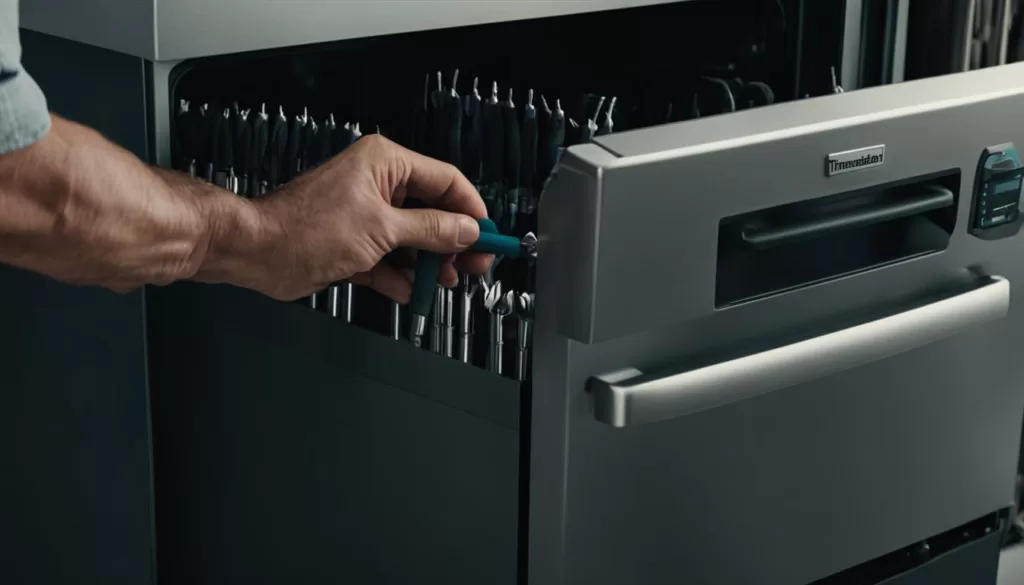
Addressing Common Drainage Problems in Thermador Dishwashers
If you’re experiencing drainage problems with your Thermador dishwasher, it can be frustrating and inconvenient. However, there are several common issues that may be causing this problem. By understanding these issues and implementing some simple solutions, you can effectively address the drainage problems in your Thermador dishwasher.
1. Blockages in the Drain Lines
One of the most common causes of drainage problems in Thermador dishwashers is blockages in the drain lines. Over time, food particles, debris, and even small objects can accumulate in the drain lines, preventing proper drainage. To address this issue, follow these steps:
- Turn off the dishwasher and unplug it from the power source for safety.
- Remove the bottom rack from the dishwasher to access the drain area.
- Inspect the drain lines for any visible blockages. If you see any debris or clogs, carefully remove them.
- Once the blockages are cleared, run hot water through the drain lines to flush out any remaining residue.
2. Debris-Blocked Drain Pump
Another common culprit behind drainage problems is a debris-blocked drain pump. The drain pump is responsible for removing the water from the dishwasher during the drain cycle. If it becomes clogged with food particles or other debris, it can hinder proper drainage. Here’s what you can do:
- Turn off the dishwasher and unplug it from the power source.
- Locate the drain pump, which is usually located at the bottom of the dishwasher.
- Remove any debris or blockages from the drain pump using a soft brush or cloth.
- After cleaning the drain pump, reconnect any hoses or connections that were disconnected.
3. Dirty Dishwasher Filter
Your Thermador dishwasher also has a filter that helps prevent debris from clogging the drain. Over time, this filter can become dirty and affect the dishwasher’s drainage. To clean the filter:
- Turn off the dishwasher and unplug it from the power source.
- Locate the dishwasher filter, which is typically at the bottom of the dishwasher.
- Remove the filter and rinse it under running water to remove any debris.
- Inspect the filter for any damage or signs of wear. If necessary, replace the filter.
- Once the filter is clean, reinsert it back into the dishwasher.
By addressing these common drainage problems in your Thermador dishwasher, you can restore its functionality and ensure proper drainage during every cycle.
Conclusion
Proper maintenance and troubleshooting are key to keeping your Thermador dishwasher running smoothly and ensuring sparkling clean dishes. By following the tips and steps outlined in this guide, you can address common issues and prevent further damage to your appliance.
Regularly check the water supply, temperature, and quality to ensure optimal performance. Take time to inspect and clean the spray arms, detergent dispenser, and filter for any blockages or buildup. Use the right detergent and follow the recommended amount for each load to avoid poor cleaning results.
However, if you find yourself unable to resolve a problem or the issue persists, it’s always wise to seek professional Thermador dishwasher repair services. Trained technicians have the expertise and tools to diagnose and fix complex issues with your appliance, ensuring it is restored to its full functionality.
Remember, maintaining your Thermador dishwasher is an investment in its longevity and performance. With proper care and attention, you can enjoy efficient cleaning and peace of mind in your kitchen for years to come.
FAQ
What are some common issues with Thermador dishwashers?
One common issue with Thermador dishwashers is when they don’t clean dishes well. This can be caused by various factors, such as a problem with the water supply, incorrect dishwasher usage, or malfunctioning parts.
How can I troubleshoot my Thermador dishwasher if it’s not cleaning well?
Troubleshooting steps you can take include checking the water temperature, assessing for hard water, inspecting the water inlet valve, and ensuring proper usage of detergent.
What should I do if I notice white spots on my clean dishes after running a cycle in my Thermador dishwasher?
If you notice white spots on your clean dishes, it could be due to hard water or etching. Using more rinse aid, adding additional salt for built-in water softening systems, and adjusting the wash settings can help address this issue.
How can I maintain the spray arms in my Thermador dishwasher?
Regular cleaning of the spray arms is essential for maintaining the performance of your Thermador dishwasher. Removing and rinsing the spray arms under running water, using a toothpick to dislodge any blockages, can improve their functionality.
What should I do if I’m experiencing poor cleaning performance in my Thermador dishwasher?
Using the wrong detergent or an incorrect amount of detergent can result in poor cleaning performance in Thermador dishwashers. It’s important to use dishwasher detergent formulated specifically for dishwashers and follow the recommended amount for each load. Checking the detergent dispenser and ensuring its proper functioning is also crucial.
How can I address drainage problems in my Thermador dishwasher?
If you’re experiencing drainage problems, it could be due to blockages in the drain lines, a debris-blocked drain pump, or a dirty dishwasher filter. Clearing these blockages and properly cleaning the filter can help resolve the issue.
What should I do if I can’t resolve a problem with my Thermador dishwasher on my own?
If you’re unable to resolve a problem on your own, it’s recommended to seek professional Thermador dishwasher repair services.
